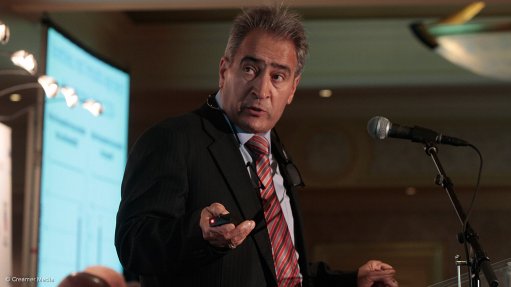
Pan-African Investment and Research Services CEO Dr Iraj Abedian
Photo by: Duane Daws
Respondents to the Manufacturing Circle’s quarterly Manufacturing Bulletin surveys have become increasingly pessimistic about the outlook for the sector, notwithstanding a recovery in output in September and improvement to the Purchasing Managers' Index (PMI).
Pan-African Investment and Research Services CEO Dr Iraj Abedian, who compiles the bulletin on behalf of the lobby group, reports that the majority (over 65%) of the 62 respondents to the third-quarter survey described the outlook as ‘fragile or weak’ or even ‘poor’ for the coming 6 to 24 months.
This represented a marked deterioration from the same period in 2013, when 52% of respondents expressed negativity about prospects. An analysis of responses over eight quarters showed that there was “momentum” behind the pessimism, with a consistent deterioration over the period.
“I am getting worried about a deepening psyche of pessimism in this industry,” Abedien said.
He also did not anticipate the 8% year-on-year improvement in manufacturing production in September, which was better than expectations, would result in a change to attitudes. Respondents, he added, had persistently expressed pessimism in the past even during periods when the PMI had recovered.
“We need to be worried about this . . . if I had anything to do with the Cabinet, this would cause me to drop everything else and start dealing with it urgently. This is about jobs, this is about growth, this is about tax revenue, this is about beneficiation – this is about everything that we as a country want to do.”
Some of the concerns raised by respondents, the majority of which were firms that employed fewer than 500 people and had yearly revenues of less than R300-million, included: a lack of clarity on South Africa’s beneficiation strategy, rising input costs, low economic growth and a high level of consumer indebtedness.
The metals and engineering manufacturing subsector had also experienced a month-long strike in July and respondents indicated that they were concerned that labour cost increases were not associated with concomitant increases in productivity.
The National Treasury expected the South Africa economy to expand by only 1.4% this year and by 2.5% in 2015, which was also likely to dampen demand for manufactured products.
Respondents were also concerned about sluggish domestic construction and mining activity and the prospects for further resources sector weakness in light of weaker commodity prices.
The tailwind provided by the decline in the value of the rand was also not translating into sharply higher domestic or export sales, owing to weak demand conditions internally and externally.
However, eight out of ten respondents were now exporting to Africa, which had emerged as the most important export destination of South African-produced manufactured products.